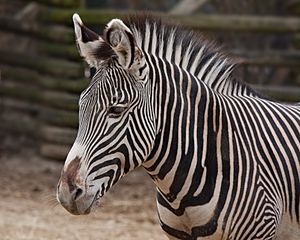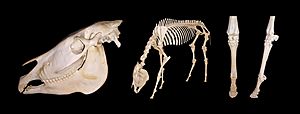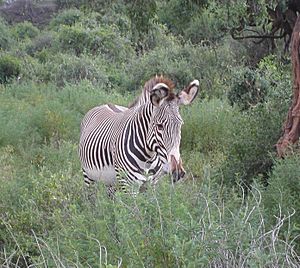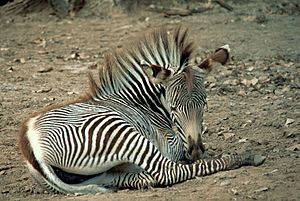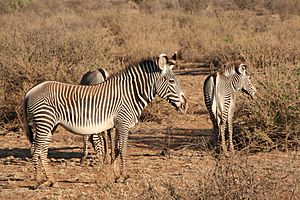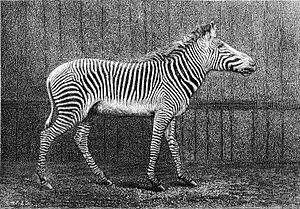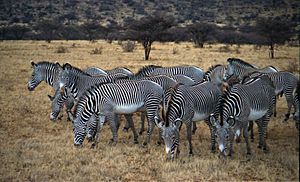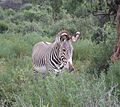Grévy's zebra facts for kids
Quick facts for kids Grévy's zebra |
|
|---|---|
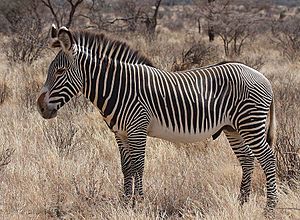 |
|
| A Grévy's zebra at Buffalo Springs National Reserve. | |
| Conservation status | |
| Scientific classification | |
| Genus: |
Equus
|
| Species: |
grevyi
|
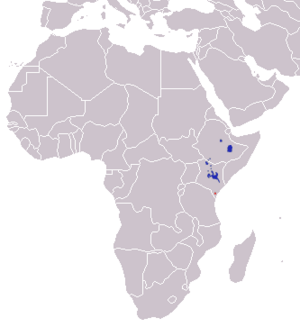 |
|
| Grévy's zebra range native introduced |
|
The Grévy's zebra (Equus grevyi), also called the imperial zebra, is the biggest wild animal in the horse family. It is also the most endangered of the three zebra species. The other two are the plains zebra and the mountain zebra.
This zebra is named after Jules Grévy, a former president of France. You can find Grévy's zebras in Kenya and Ethiopia. They are taller than other zebras, have big ears, and their stripes are thinner.
Grévy's zebras live in dry grasslands. They eat grasses, legumes (plants like peas or beans), and other plants. They can go up to five days without water. Unlike other zebras, they don't live in large family groups called harems. Their social life is mostly about male zebras defending their areas and mothers taking care of their foals.
This zebra is considered an endangered animal. Its population has dropped a lot, from 15,000 in the 1970s to about 3,000 today. However, in 2008, their numbers seemed to be stable.
Contents
What is a Grévy's Zebra?
The Grévy's zebra is the largest wild horse-like animal. It measures about 2.5 to 2.75 meters (8.2 to 9 feet) long from head to body. Its tail is about 55 to 75 centimeters (22 to 30 inches) long. These zebras stand about 1.45 to 1.6 meters (4.8 to 5.2 feet) tall at the shoulder. They weigh between 350 and 450 kilograms (770 to 990 pounds).
Grévy's zebras look a bit like mules. They have a large, long, and narrow head with big nostrils. Their ears are very large, round, and cone-shaped. Their neck is short but thick. The zebra's muzzle is grey to black, and its lips have whiskers. The mane on its neck is tall and stands straight up. Young zebras have a mane that goes all the way down their back, but it gets shorter as they grow up.
Like all zebras, the Grévy's zebra has black and white stripes. Its stripes are narrow and close together. They are wider on the neck and go all the way down to the hooves. The belly and the area around the tail are white, with no stripes. This is special to the Grévy's zebra.
Baby zebras are born with brown and white stripes. The brown stripes turn darker as they get older. Scientists believe the zebra's natural color is dark, and the white stripes are an added pattern. The stripes might help the zebra look bigger than it is or hide its shape. A zebra standing still can be hard to see at night or in the shade. Some studies suggest that stripes might help keep biting horse-flies away. Other ideas are that moving stripes can confuse predators or insects.
Where Grévy's Zebras Live and What They Eat
Grévy's zebras mostly live in northern Kenya. There are also some small groups in Ethiopia. They used to live in Somalia and Djibouti but are no longer found there. Their status in South Sudan is not clear. They live in areas with Acacia and Commiphora bushes and dry plains.
These zebras eat grasses, legumes, and other plants. They often eat leaves and twigs when grass is scarce. Their digestive system allows them to eat food that is not very nutritious. Grévy's zebras can survive up to a week without water. However, they drink every day if water is available. During the dry season, they often move to higher areas where there is more water. Mothers who are nursing their babies need much more water. During droughts, zebras will dig holes to find water and protect these spots.
The main predator of the Grévy's zebra is the lion. Adult zebras can also be hunted by spotted hyenas. African hunting dogs, cheetahs, and leopards rarely attack adult zebras. However, they sometimes hunt young zebras. Mothers are very protective of their babies. Zebras can also get sick from different stomach parasites.
Grévy's Zebra Behavior and Life Cycle
Adult male zebras, called stallions, usually live in their own territories during the wet seasons. Some might stay in their territory all year if there is enough water. Stallions that don't have a territory roam freely. They are known as bachelors. Female zebras, called mares, young zebras, and bachelors wander over large areas. Mares will move from one territory to another, looking for the best food and water.
Up to nine stallions might compete for a mare outside of a territory. Stallions with territories usually allow other stallions to pass through their area. But if a mare is ready to mate, the territorial stallion will keep other stallions away. Non-territorial stallions might avoid these areas to prevent trouble. When mares are not around, a territorial stallion might spend time with other stallions. A dominant stallion shows his power by arching his neck and walking with high steps. Less dominant stallions show they submit by extending their tail, lowering their heads, and gently touching the dominant stallion's chest or groin.
Zebras make many different sounds. When they are scared, they make deep, hoarse grunts. They also make whistles and squeals when alarmed, fighting, or in pain. They might snort when scared or as a warning. A stallion will bray to defend his territory, to guide mares, or to keep other stallions away. Barks might be heard during mating. Baby zebras will squeal if they are in distress. The sound of a Grévy's zebra has been described as "something like a hippo's grunt mixed with a donkey's wheeze."
To get rid of flies or parasites, zebras roll in dust, water, or mud. They also twitch their skin to shake off flies. They rub against trees, rocks, and other objects to relieve itchy skin, hair, or parasites. Even though Grévy's zebras don't groom each other, they sometimes rub against another zebra.
Reproduction and Foals
A Grévy's zebra mare is pregnant for about 390 days. She usually gives birth to one foal. A newborn zebra will follow anything that moves. So, new mothers keep other mares away from their foals. This helps the foal learn its mother's stripes, smell, and sounds.
Mares with young foals might gather in small groups. Mares sometimes leave their foals in "kindergartens" while they go to find water. The foals don't hide, so they can be at risk from predators. However, these kindergartens are usually protected by an adult, often a territorial stallion. A mare with a foal stays with one dominant stallion. He has the right to mate with her. Even if the foal is not his, the stallion will protect it to make sure the mare stays in his territory.
To survive in dry areas, Grévy's zebra foals nurse for longer periods. They also wait until they are three months old before they start drinking water. Even though young zebras become less dependent on their mothers after about six months, they may stay with them for up to three years.
Grévy's Zebras and Humans
People in ancient times in Europe knew about the Grévy's zebra. The Romans even used them in their circuses. But then, people in the Western world forgot about them for a thousand years.
In the 1600s, the king of Shoa (now central Ethiopia) sent two zebras as gifts. One went to the Sultan of Turkey, and the other to the Dutch governor of Jakarta. Much later, in 1882, the government of Abyssinia (Ethiopia) sent one to the French president, Jules Grévy. That's when this animal was recognized as its own unique species and named in Grévy's honor.
Status and Protecting Grévy's Zebras
The Grévy's zebra is an endangered animal. In the 1970s, there were about 15,000 of them. By the early 2000s, their population had dropped to less than 3,500. This is a 75% decrease. Today, it's thought that fewer than 2,500 Grévy's zebras live in the wild. There are also about 600 Grévy's zebras living in zoos and special centers. These captive groups have been successful, like at White Oak Conservation in Florida, USA, where over 70 foals have been born. Research there is helping with breeding programs. As of 2008, the Grévy's zebra population trend was considered stable.
Grévy's zebras are legally protected in Ethiopia. In Kenya, a hunting ban from 1977 protects them. In the past, hunting for their valuable skins was a big threat. However, hunting has decreased. Now, the main dangers to the zebra are losing their habitat and competition with farm animals. Cattle often gather around watering holes, and Grévy's zebras are sometimes kept away from these areas by fences.
Efforts by local communities have been the most successful in protecting Grévy's zebras and their homes. Less than 0.5% of the Grévy's zebra's range is in protected areas. In Ethiopia, these areas include Alledeghi Wildlife Reserve and Yabelo Wildlife Sanctuary. In Kenya, important protected areas are Buffalo Springs, Samburu, and Shaba National Reserves. There are also private and community-owned wildlife areas in Isiolo, Samburu, and the Laikipia Plateau.
An invasive plant called mesquite was brought to Ethiopia around 1997. This plant is now threatening the zebra's food supply. It is taking over the areas where two important grass species, Cenchrus ciliaris and Chrysopogon plumulosus, grow. These grasses are what the zebras eat most of the time.
Images for kids
See also
 In Spanish: Cebra de Grévy para niños
In Spanish: Cebra de Grévy para niños



